Abstract
The effects of anemia upon the ventilatory responses to transient and steady-state hypoxia were studied in unanesthetized goats. Responses to transient hypoxia (inhalation of several breaths of nitrogen) were considered to reflect peripheral chemoreceptor and non-chemoreceptor influences of hypoxia upon ventilatory control. In all goats, severe anemia (hemoglobin 3.1-4.8 g/100ml) markedly heightened the responses to transient hypoxia (from a mean of 0.27 to a mean of 0.75 liter/min/percent fall in SaO2). This phenomenon was substantially reversed by alpha-adrenergic blockade (phenoxybenzamine, 5 mg/kg). In contrast, the ventilatory responses to steady-state hypoxia were unaffected by severe anemia. These data suggest that severe anemia enhances the peripheral chemoreceptor-mediated response to hypoxia through a mechanism involving the alpha-adrenergic system. It also appears that a ventilatory depressant effect of hypoxia which is not mediated by the peripheral chemoreceptors is also enhanced by severe anemia, thereby preventing an increase in the steady-state ventilatory response to hypoxia. Finally, experiments involving variation in oxygen affinity of hemoglobin suggested that O2 tension rather than O2 availability in arterial blood is the major determinant of peripheral chemoreceptor activity.
Full text
PDF
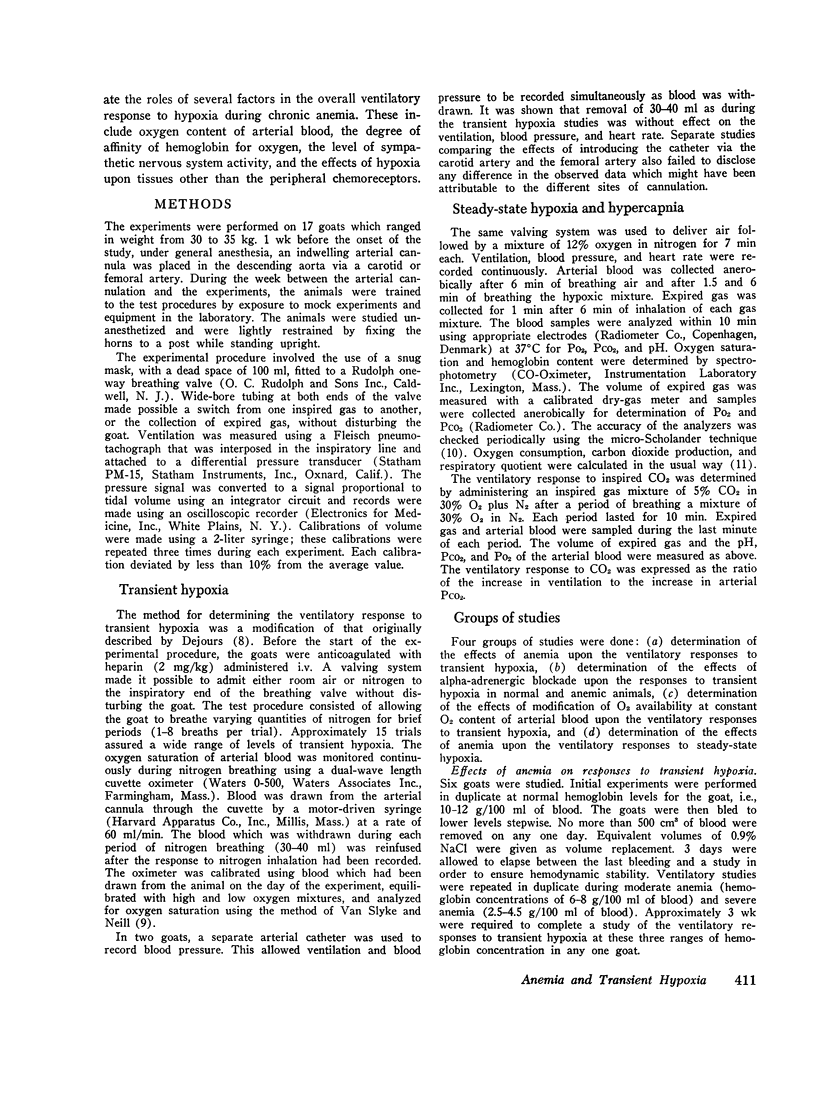
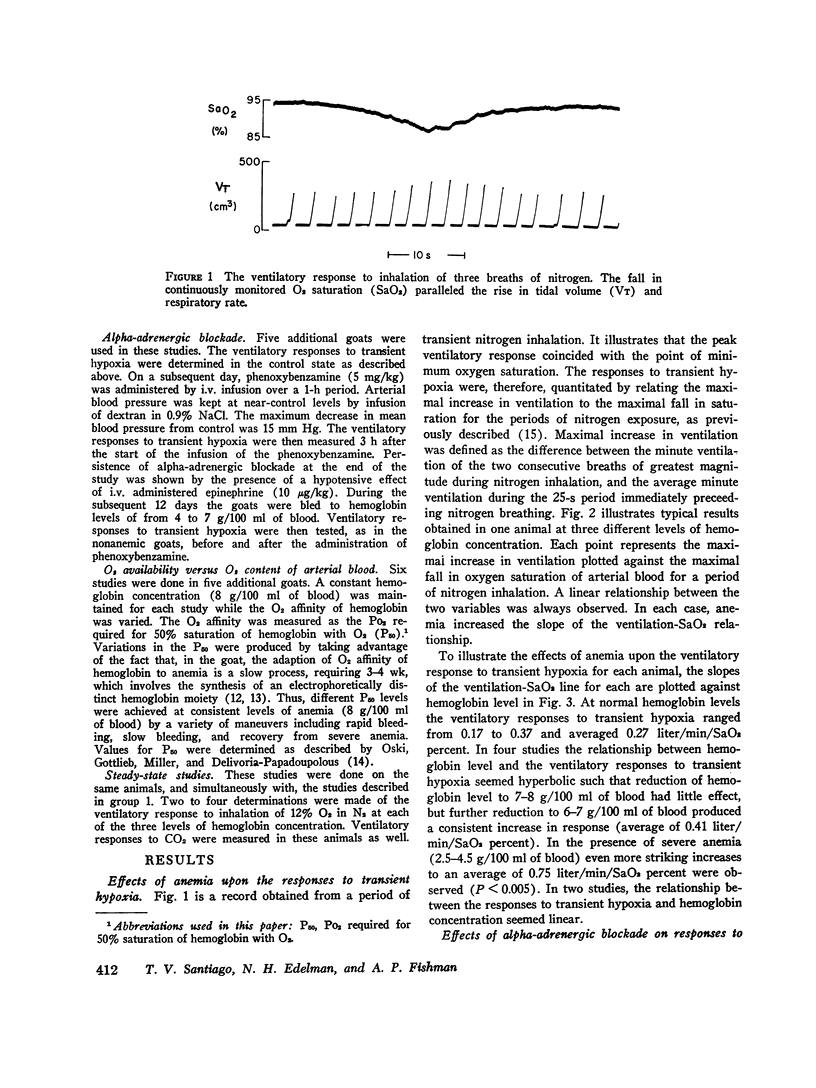
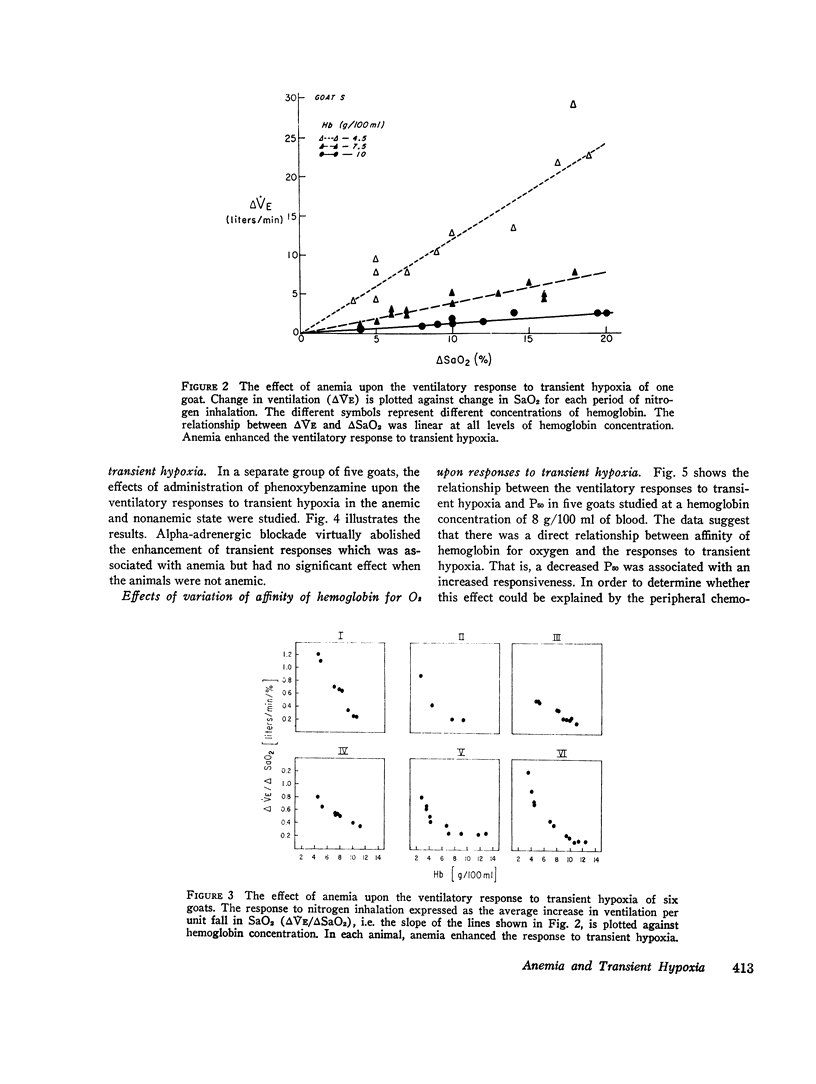
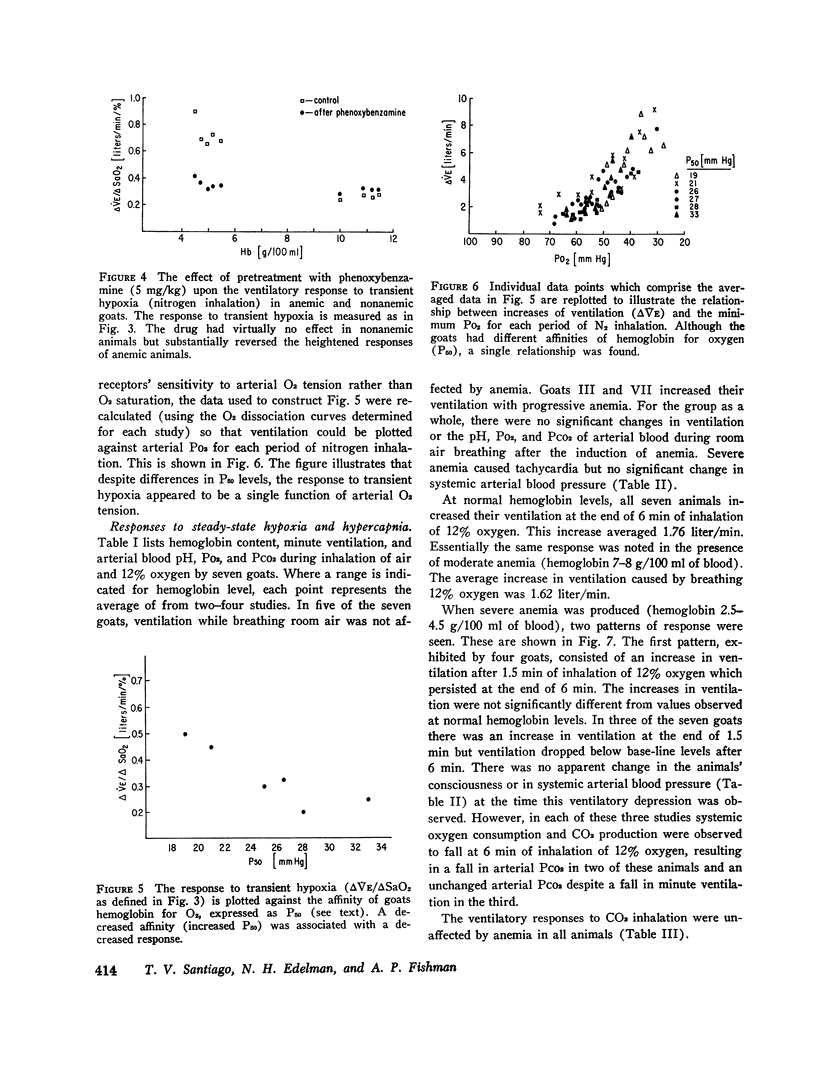
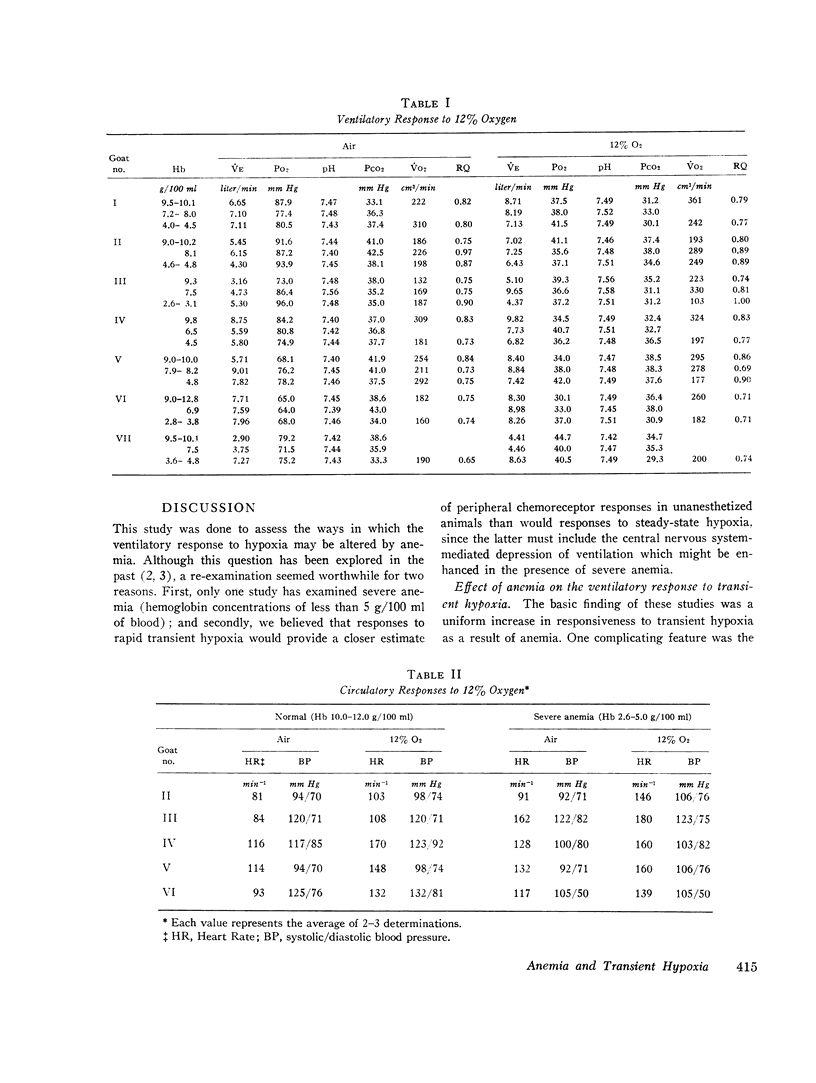


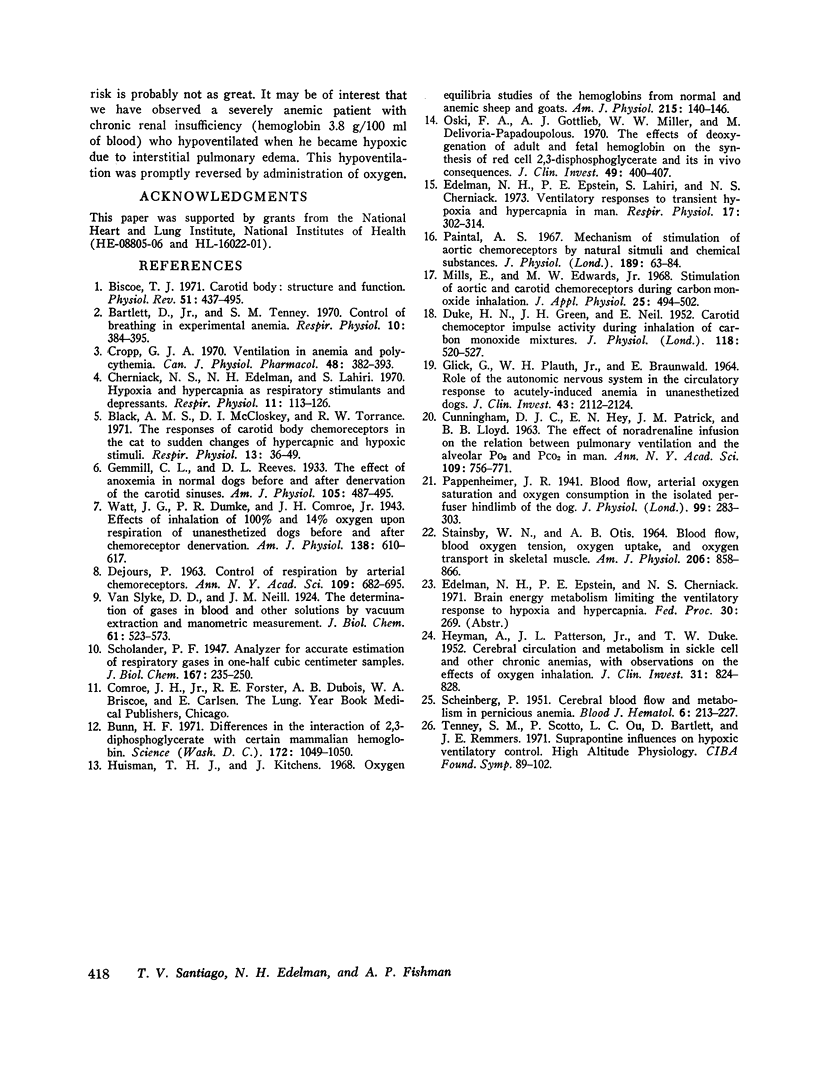
Selected References
These references are in PubMed. This may not be the complete list of references from this article.
- Bartlett D., Jr, Tenney S. M. Control of breathing in experimental anemia. Respir Physiol. 1970 Oct;10(3):384–395. doi: 10.1016/0034-5687(70)90056-3. [DOI] [PubMed] [Google Scholar]
- Biscoe T. J. Carotid body: structure and function. Physiol Rev. 1971 Jul;51(3):437–495. doi: 10.1152/physrev.1971.51.3.437. [DOI] [PubMed] [Google Scholar]
- Bunn H. F. Differences in the interaction of 2,3-diphosphoglycerate with certain mammalian hemoglobins. Science. 1971 Jun 4;172(3987):1049–1050. doi: 10.1126/science.172.3987.1049. [DOI] [PubMed] [Google Scholar]
- CUNNINGHAM D. J., HEY E. N., PATRICK J. M., LLOYD B. B. The effect of noradrenaline infusion on the relation between pulmonary ventilation and the alveolar PO2 and PCO2 in man. Ann N Y Acad Sci. 1963 Jun 24;109:756–771. doi: 10.1111/j.1749-6632.1963.tb13504.x. [DOI] [PubMed] [Google Scholar]
- Cherniack N. S., Edelman N. H., Lahiri S. Hypoxia and hypercapnia as respiratory stimulants and depressants. Respir Physiol. 1970;11(1):113–126. doi: 10.1016/0034-5687(70)90107-6. [DOI] [PubMed] [Google Scholar]
- Cropp G. J. Ventilation in anemia and polycythemia. Can J Physiol Pharmacol. 1970 Jun;48(6):382–393. doi: 10.1139/y70-061. [DOI] [PubMed] [Google Scholar]
- DEJOURS P. Control of respiration by arterial chemoreceptors. Ann N Y Acad Sci. 1963 Jun 24;109:682–695. doi: 10.1111/j.1749-6632.1963.tb13497.x. [DOI] [PubMed] [Google Scholar]
- DUKE H. N., GREEN J. H., NEIL E. Carotid chemoceptor impulse activity during inhalation of carbon monoxide mixtures. J Physiol. 1952 Dec;118(4):520–527. doi: 10.1113/jphysiol.1952.sp004813. [DOI] [PMC free article] [PubMed] [Google Scholar]
- Edelman N. H., Epstein P. E., Lahiri S., Cherniack N. S. Ventilatory responses to transient hypoxia and hypercapnia in man. Respir Physiol. 1973 Apr;17(3):302–314. doi: 10.1016/0034-5687(73)90005-4. [DOI] [PubMed] [Google Scholar]
- GLICK G., PLAUTH W. H., Jr, BRAUNWALD E. ROLE OF THE AUTONOMIC NERVOUS SYSTEM IN THE CIRCULATORY RESPONSE TO ACUTELY INDUCED ANEMIA IN UNANESTHETIZED DOGS. J Clin Invest. 1964 Nov;43:2112–2124. doi: 10.1172/JCI105085. [DOI] [PMC free article] [PubMed] [Google Scholar]
- HEYMAN A., PATTERSON J. L., Jr, DUKE T. W. Cerebral circulation and metabolism in sickle cell and other chronic anemias, with observations on the effects of oxygen inhalation. J Clin Invest. 1952 May;31(9):824–828. doi: 10.1172/JCI102668. [DOI] [PMC free article] [PubMed] [Google Scholar]
- Huisman T. H., Kitchens J. Oxygen equilibria studies of the hemoglobins from normal and anemic sheep and goats. Am J Physiol. 1968 Jul;215(1):140–146. doi: 10.1152/ajplegacy.1968.215.1.140. [DOI] [PubMed] [Google Scholar]
- Mills E., Edwards M. W., Jr Stimulation of aortic and carotid chemoreceptors during carbon monoxide inhalation. J Appl Physiol. 1968 Nov;25(5):494–502. doi: 10.1152/jappl.1968.25.5.494. [DOI] [PubMed] [Google Scholar]
- Oski F. A., Gottlieb A. J., Miller W. W., Delivoria-Papadopoulos M. The effects of deoxygenation of adult and fetal hemoglobin on the synthesis of red cell 2,3-diphosphoglycerate and its in vivo consequences. J Clin Invest. 1970 Feb;49(2):400–407. doi: 10.1172/JCI106249. [DOI] [PMC free article] [PubMed] [Google Scholar]
- Paintal A. S. Mechanism of stimulation of aortic chemoreceptors by natural stimuli and chemical substances. J Physiol. 1967 Mar;189(1):63–84. doi: 10.1113/jphysiol.1967.sp008155. [DOI] [PMC free article] [PubMed] [Google Scholar]
- Pappenheimer J. R. Blood flow, arterial oxygen saturation, and oxygen consumption in the isolated perfused hindlimb of the dog. J Physiol. 1941 Mar 25;99(3):283–303. doi: 10.1113/jphysiol.1941.sp003901. [DOI] [PMC free article] [PubMed] [Google Scholar]
- SCHEINBERG P. Cerebral blood flow and metabolism in pernicious anemia. Blood. 1951 Mar;6(3):213–227. [PubMed] [Google Scholar]
- STAINSBY W. N., OTIS A. B. BLOOD FLOW, BLOOD OXYGEN TENSION, OXYGEN UPTAKE, AND OXYGEN TRANSPORT IN SKELETAL MUSCLE. Am J Physiol. 1964 Apr;206:858–866. doi: 10.1152/ajplegacy.1964.206.4.858. [DOI] [PubMed] [Google Scholar]


